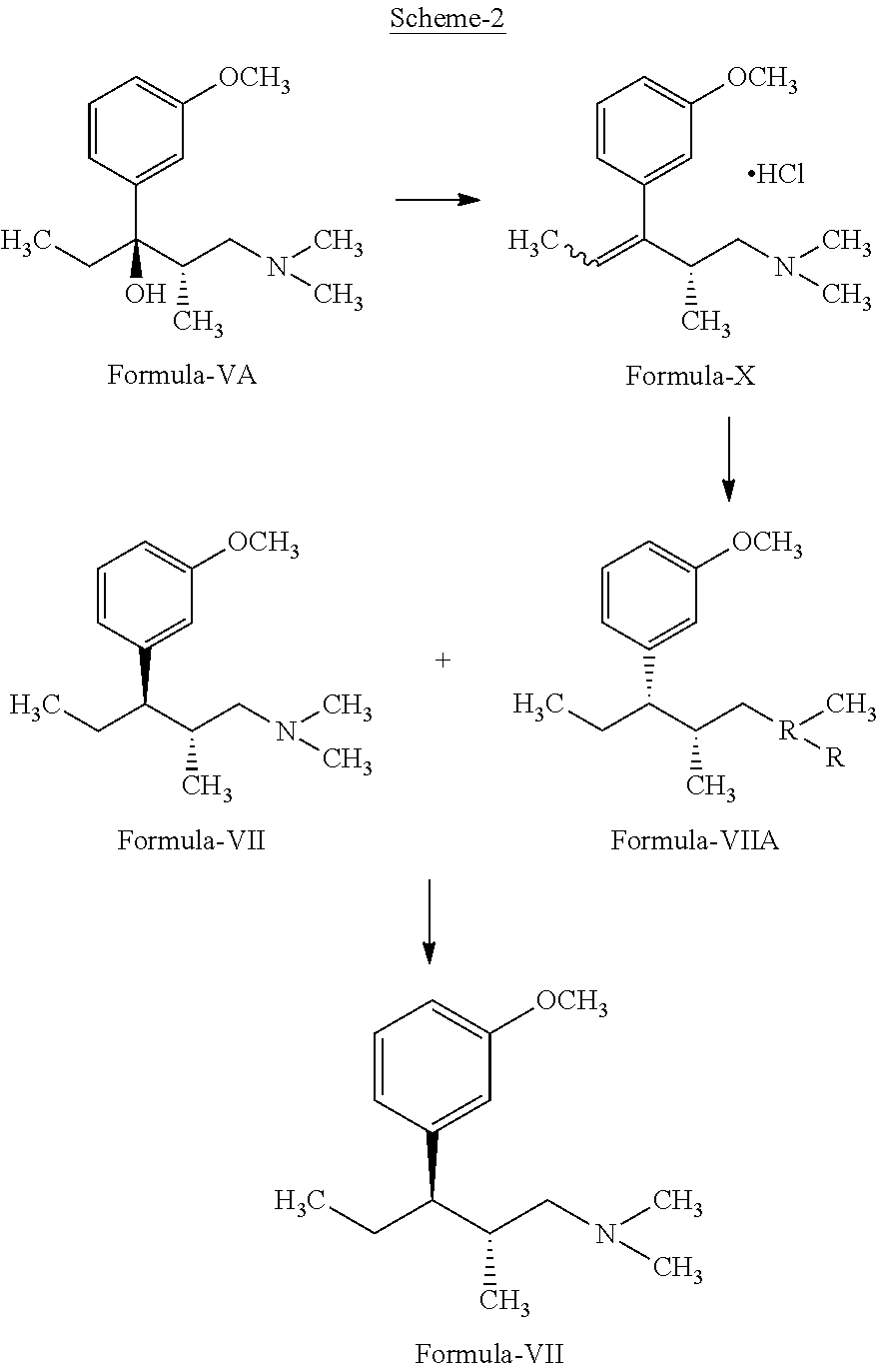Process for the preparation of tapentadol
a tapentadol and process technology, applied in the field of tapentadol preparation, can solve the problems of uneconomical process and lower yield, and achieve the effect of improving safety and cleaning reaction
- Summary
- Abstract
- Description
- Claims
- Application Information
AI Technical Summary
Benefits of technology
Problems solved by technology
Method used
Image
Examples
example-1
Preparation of (2S,3R)-1-(dimethylamino)-3-(3-methoxyphenyl)-2-methyl pentan-3-ol
[0063]In a dry flask charged magnesium turning (41.0 gm 1.70 M) in tetrahydrofuran (200 ml). Under nitrogen atmosphere charged 3-Bromo anisole (20.0 gm; 0.106 M), iodine crystal (0.2 gm). Stirred and heated the reaction mass to 68-75° C. After initiation of the reaction the remaining quantity of 3-Bromo anisole (307 gm, 1.641 M) was added maintaining the reaction at reflux. Stirred and maintained the reaction mass at refluxed for 1 hrs, cooled to 25-30° C. Slowly added (2S)-1-(dimethylamino)-2-methylpentan-3-one (100.0 gm, 0.699 M) maintaining the temperature of the reaction at 25-30° C. The reaction mass was maintained for 12 hour at 25-30° C. and then quenched the reaction mass in ice cold D. M. water (1.0 Liter). Stirred and adjusted the pH of the reaction mass to 3-4 with acetic acid. Further adjusted the pH to 9-10 using ammonia solution. Stirred the reaction mass 30 minutes and extracted the react...
example-2
Preparation of (2S,3R)-1-(dimethylamino)-3-(3-methoxyphenyl)-2-methylpentan-3-yl 4-methylsulfonate
[0066]Charged (2S,3R)-1-(dimethylamino)-3-(3-methoxyphenyl)-2-methyl pentan-3-ol (100.0 gm, 0.398 M) and tetrahydrofuran (200 ml) in a dry R.B. Flask. Stirred at 25-30° C. and charged slowly conc. Sulfuric acid (42.94 gm, 0.438 M). Under stirring charged methanesulfonic acid (42.07 gms, 0.438 M) and cyclohexane (300 ml). Raised the temperature of the reaction mass to 78° C. and maintained at 76-80° C. for 3.0 hours with simultaneous removal of water. Quenched the reaction mass with water (500 ml) and adjusted the pH of the aqueous layer to 8-9 with aqueous sodium hydroxide solution. Extracted the aqueous layer with cyclohexane and separated the organic layer. Distilled out solvent under reduced pressure to get the compound ((2S,3R)-1-(dimethylamino)-3-(3-methoxyphenyl)-2-methyl-pentan-3-yl-4-methylsulfonate.
[0067]Yield=117.96 gm
[0068]% Yield=90.0%.
example-3
Preparation of (2R,3R)-3-(3-methoxyphenyl)-N,N2-trimethyl pentan-1-amine
[0069]Charged ((2S,3R)-1-(dimethylamino)-3-(3-methoxyphenyl)-2-methyl-pentan-3-yl 4-methylsulfonate (100.0 gm, 0.303 M) and tetrahydrofuran (200 ml) in an autoclave. Charged 10% Pd / C (5.06 gm) and flushed the autoclave with nitrogen under stirring. Pressurized the reaction mass with 5.0 kg hydrogen gas. The reaction mass maintained for 2-4 hours at 25-30° C. Filtered the catalyst Pd / C from the reaction mass and filtrate was concentrated under reduced pressure to get residual oil. To the residue charged DM water (200 ml) and washed the solution with toluene. Separated the aqueous layer and cooled to 0-5° C. Adjusted the pH to 9-10 with aqueous sodium hydroxide solution. The above reaction mass was extracted with 3×200 ml diisopropyl ether and separated the organic layer. Combined organic layer was concentrated under reduced pressure to get the compound (2R,3R)-3-(3-methoxyphenyl)-N,N2-trimethyl pentan-1-amine.
[00...
PUM
| Property | Measurement | Unit |
|---|---|---|
| temperature | aaaaa | aaaaa |
| temperature | aaaaa | aaaaa |
| temperature | aaaaa | aaaaa |
Abstract
Description
Claims
Application Information
 Login to View More
Login to View More - R&D
- Intellectual Property
- Life Sciences
- Materials
- Tech Scout
- Unparalleled Data Quality
- Higher Quality Content
- 60% Fewer Hallucinations
Browse by: Latest US Patents, China's latest patents, Technical Efficacy Thesaurus, Application Domain, Technology Topic, Popular Technical Reports.
© 2025 PatSnap. All rights reserved.Legal|Privacy policy|Modern Slavery Act Transparency Statement|Sitemap|About US| Contact US: help@patsnap.com



